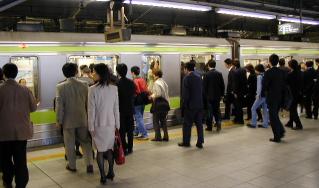Yamanote Line
|
|
The Yamanote Line (山手線; Yamanote-sen) is one of Tokyo's busiest and most important commuter lines. Running as a circle, it connects most of Tokyo's major stations and urban centres including the Ginza area, Shibuya, Shinjuku and Ikebukuro. Only six of its 29 stations do not connect with other railway or underground (subway) lines.
| Contents |
Service
Trains run from about 4:30 am to about 1:20 am at intervals of 2.5 minutes at peak time. A complete loop takes 61 to 65 minutes. All trains stop at each station. Trains are put into and taken out of service at Osaki (which for timetabling purposes is the line's start and terminus) and sometimes Ikebukuro.
Trains which run clockwise are known as "soto-mawari" (外回り, outer circle) and anti-clockwise as "uchi-mawari" (内回り, inner circle).
The Yamanote Line is the only major line in Tokyo which does not have any through-running services to other lines.
The line also acts as a fare zone destination for JR tickets from locations outside Tokyo, permitting travel to any JR station on or within the loop.
All of the rolling stock and diagrams use the same color, Yellow Green #6 ■ (Munsell code 7.5GY 6.5/7.8).
History
The Yamanote Line originated in 1885 with the construction of the Shinagawa line between Shinagawa and Akabane, bypassing the then built up areas and providing the first north-south rail link through Tokyo. The top part of the loop between Ikebukuro and Tabata was completed in 1903 (known as the Toshima line, 豊島線) and in 1909 following electrification both lines were merged to become the Yamanote Line.
The complete loop was only completed in 1925 with the opening of the section of track between Kanda and Ueno, providing a north-south link via Tokyo station through the city's centre. The contemporary Yamanote Line came into being in 1956 when it was separated from the Keihin-Tōhoku Line and was given its own set of tracks along the eastern side of the loop between Shinagawa and Tabata.
Name
"Yamanote" literally means "mountain hand" and in many Japanese cities is used to refer to inland, hillier districts (as opposed to areas close to the sea). In Tokyo "Yamanote" - as opposed to the lower lying "Shitamachi" (下町) - lies along the western side of the Yamanote Line loop.
Yamanote-sen is always written without the kana "no" (の or ノ). In the past it was sometimes transliterated as "Yamate" on train signboards. Although "Yamanote-sen" has always been the official term, "Yamate-sen" was very popular among passengers until 1971, when the then-JNR (Japan National Railways) changed all transliterations to "Yamanote" to reduce confusion. One of the reasons for this is the existence of "Yamate" station on the Negishi line in Yokohama, very close to the Yamanote line. However, some of the older generation still refer to the line as the Yamate line.
Note that in other areas of Japan, 山手 may be pronounced "yamate", for example the Seishin-Yamate Line in Kōbe.
Trains
Services are provided by E231 series trains introduced from 2003 onwards replacing the 205 series, first introduced in 1985 and phased out in April 2005. Each train consists of 11 cars.
Yamanote-sen-205-cattle-wagon.jpg
A notorious feature of both the 205 and E231 series trains are their "cattle wagons", compartments in which the bench seats are folded back to provide standing room only during the morning rush hour (until 10am). The E231 series train has two of these cars in each set, officially nicknamed "roku-tobira-sha" (literally, "6 door car") - all the other cars have four sets of doors on each side.
The E231 series supports a new type of traffic control system, called digital ATC (Automatic Train Control), which will help reduce one round trip to a very short 58 minutes. The series also has a more modern design and has two 15" LCD monitors above each door, displaying commercials, news and weather on one screen and information on the next stop (in both Japanese and English), notification of delays on the Yamanote and other lines on the other.
Stations
Listed clockwise:
Yamanote.png
- Tōkyō (東京)
- Yūrakuchō (有楽町)
- Shinbashi (新橋)
- Hamamatsuchō (浜松町)
- Tamachi (田町)
- Shinagawa (品川)
- Ōsaki (大崎)
- Gotanda (五反田)
- Meguro (目黒)
- Ebisu (恵比寿)
- Shibuya (渋谷)
- Harajuku (原宿)
- Yoyogi (代々木)
- Shinjuku (新宿)
- Shin-Ōkubo (新大久保)
- Takadanobaba (高田馬場)
- Mejiro (目白)
- Ikebukuro (池袋)
- Ōtsuka (大塚)
- Sugamo (巣鴨)
- Komagome (駒込)
- Tabata (田端)
- Nishi-Nippori (西日暮里)
- Nippori (日暮里)
- Uguisudani (鶯谷)
- Ueno (上野)
- Okachimachi (御徒町)
- Akihabara (秋葉原)
- Kanda (神田)
Since the distance between Shinagawa and Tamachi stations is 2.2km, making it the longest stretch of track on the Yamanote line, there are plans for a new station between those two stations with completion in or around 2010.
External links
- japan-guide.com: JR Yamanote Line (http://www.japan-guide.com/e/e2370.html/)ja:山手線 de:Yamanote-Linie fr:Yamanote

